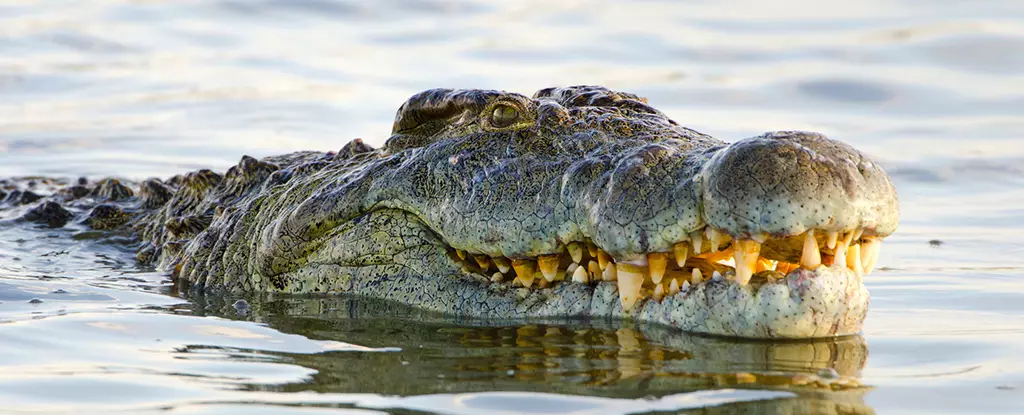Crocodiles, often perceived as fierce predators of the water, possess a unique attribute that intrigues scientists and nature enthusiasts alike: their signature smile. Unlike the playful grins associated with cartoon depictions, the crocodile’s expression encompasses a fascinating evolutionary story. The examination of these creatures at the embryonic stage has revealed complex mechanisms that give rise to their smirking visage and distinct head scales.
Researchers at the University of Geneva’s Laboratory of Artificial and Natural Evolution (LANE) have undertaken the daunting task of demystifying how the crocodile achieves its characteristic smile. The study delves into the developmental biology of Nile crocodiles (Crocodylus niloticus), revealing profound insights into the processes that shape the creature’s head. A previous study by lab leader Michel Milinkovitch provided a foundational understanding of how different textures arise in reptiles, distinguishing crocodilian scales from the hair of mammals and feathers of birds. While traditional theories primarily suggested that scale patterns developed through predefined genetic pathways, the new research presents a more nuanced view.
Traditionally, it was believed that the scales on a crocodile’s head formed primarily due to tensile stress—akin to stretch marks in humans. However, LANE’s latest findings have overturned this notion. By analyzing embryos, the researchers discovered that the scales emerge from compressive mechanical instabilities during the growth phase. Initially, the crocodile’s jaw appears smooth, but as the skin expands, an intricate network of wrinkles forms. These wrinkles evolve into the distinctive polygonal scales, with variations in size and shape between the upper and lower jaws.
This intricate process suggests a relationship between skin growth and bone development. Mutually dependent, these two growth mechanisms exhibit fascinating dynamics; the skin tends to develop at a faster rate than the underlying bone structure, leading to the formation of these unique patterns. Unlike human adolescents, whose growth spurts lead to stretch marks, embryonic crocodiles experience a far more complex interaction between their epidermis and dermis.
Experimental Insights and the Role of Epidermal Growth Factor
The research team employed innovative experimental designs to probe these mechanisms further. By injecting crocodile eggs with epidermal growth factor (EGF)—a protein pivotal for promoting skin stiffness and growth—the researchers could accelerate the developmental processes within the egg. The result was a highly exaggerated manifestation of normal scale patterns, providing a fascinating glimpse into how altered growth influences scale morphology. The enhanced EGF levels led to labyrinth-like skin folding that, upon hatching, revealed smaller polygonal head scales.
These observations indicate that embryonic skin folds undergo a remarkable transformation, further emphasizing the adaptability of crocodilian features. Interestingly, the study also provided insights into the evolutionary implications of scale formation; as various crocodilian species evolved, different head-scale patterns emerged, possibly due to environmental pressures and growth variations during embryonic development.
The revelations surrounding the mechanics of crocodile scale development underscore a broader narrative within evolutionary biology. They illustrate how functional requirements—like feeding and thermoregulation—interact with developmental processes influenced by both genetic and environmental factors. The distinct head scales of crocodiles are not merely for show; they may serve critical purposes, from aiding in hunting techniques to potentially influencing mate selection during breeding seasons.
The study’s findings reiterate the importance of examining not only the genetic components of evolution but also the mechanical forces at play throughout embryonic development. As researchers continue to uncover the complexities of animal morphology, it becomes evident that the interplay of various forces creates the diverse adaptations we see in the animal kingdom today.
The journey to uncover how crocodiles derived their signature smile has revealed a fascinating interplay of mechanical, biological, and evolutionary principles. Researchers have not only enhanced our understanding of crocodile development but also contributed to the broader narrative of how life adapts and evolves. Each wrinkle and scale tells a story, hinting at the remarkable complexity hidden beneath the surface of these ancient reptiles. Understanding these processes not only enriches our knowledge of crocodilian biology but also offers insights relevant to evolutionary theory at large.

